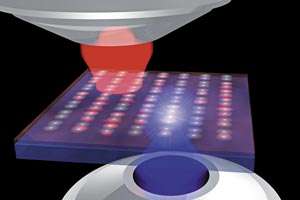Researchers develop material with optical properties that can be modified on a small scale by laser light

Properties of small areas of a versatile optical film can be tweaked by applying ultrashort pulses of laser light, A*STAR researchers show. This tunability makes the material suitable for various light-based applications, from lenses to holograms.
When the shutter button on a camera is depressed, it focuses by electrically adjusting the positions of the constituent parts of the lens. Similarly, the parameters of optical components in many devices and scientific instruments are adjusted by moving their parts, or by stretching or heating them. Being able to use light to adjust optical components would offer many advantages, including fast response and easy integration into small and robust systems.
Now, such an optically adjustable system has been developed by Qian Wang of the A*STAR Institute of Materials Research and Engineering and co-workers, along with collaborators at the University of Southampton, UK, and the Nanyang Technological University, Singapore.
The team studied a material widely used in CD and DVD disks—chalcogenide glass. In rewritable CD and DVD data-storage devices, microsecond or nanosecond (10−9 second) laser pulses are used to switch the medium between two states—crystalline and disordered. In contrast, Wang and her team used a tightly controlled series of much shorter femtosecond (10−15 second) optical pulses to set the glass into incremental states between completely crystalline and completely disordered. By scanning the focused laser beam across the glass film, they could modify regions as small as about 0.6 micrometers (see image).
"This technique allows us to build optical devices with smoothly varying properties across the surface, to erase them and then to rewrite a different structure, all on the same piece of optical canvas," notes team member, Edward Rogers, of the University of Southampton. "It can even be used to write complex structures like lenses, diffraction gratings, holograms and advanced resonant structures known as metamaterials, directly into a phase-change chalcogenide glass film."
The researchers used their system to make various optical components, including a hologram that had eight levels of gray shading.
Another advantage of the device is its compact size. "Compared to conventional bulk optical components, our optical devices are flat and much smaller, only tens of micrometers. This makes them easy to integrate into optical systems," explains Wang.
The method currently involves scanning a laser beam across the film, but in future it may be possible to use an optical-pattern generator, which would speed up writing of the film.
More information: Qian Wang et al. Optically reconfigurable metasurfaces and photonic devices based on phase change materials, Nature Photonics (2015). DOI: 10.1038/nphoton.2015.247
Journal information: Nature Photonics


















